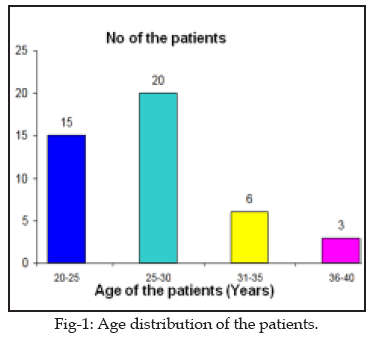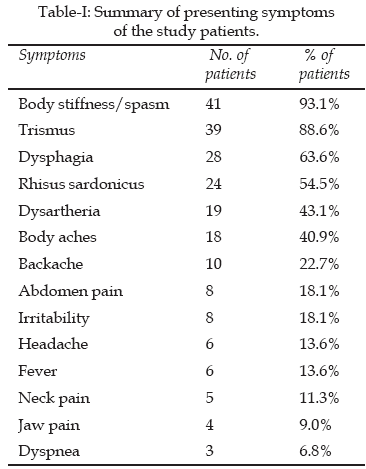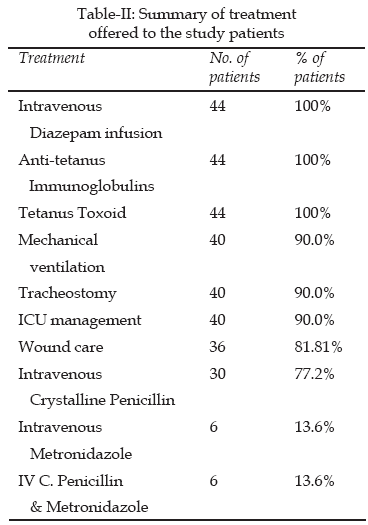|
 |
|
Published
by : PROFESSIONAL MEDICAL PUBLICATIONS |
|
ISSN 1681-715X |
|
|
|
|
|
- |
|
ORIGINAL
ARTICLE |
|
- |
|
Volume 25 |
October - December 2009
(Part-I) |
Number
5 |
|
|
|
Tetanus: Presentation and outcome in adults
Nadeem Javeed Younas1, Ali Hassan Abro2,
Kirpal Das3,
Ahmed Mahamed Saleh Abdou4, Abdulla Mohamood Ustadi5,
Shahid Afzal6
ABSTRACT
Objectives: Tetanus is still a common clinical
entity, especially in developing countries. The purpose of this study was to
evaluate the presenting features as well as the outcome of tetanus in adult
patients admitted to the hospital.
Methodology: This was a hospital based descriptive
study conducted at the Infectious Diseases Unit, Rashid Hospital Dubai, United
Arab Emirates from Jan. 2003 to Dec. 2008. The study was designed to include
demographics, clinical information and outcome observed in the patients
admitted with clinical diagnosis of tetanus. Patients with malignancy,
immunosuppression (AIDS/Drugs), significant cardiac dysfunction and renal
impairment were excluded. The patients were treated as per the standard
protocol for the management of tetanus.
Results: A total of 44 patients were enrolled into
the study. The mean age+SD of the patients were 26.3+5.8 years
and all of the study patients were males. Thirty six (81.81%) patients gave
the history of injury prior to onset of the symptoms, whereas eight (18.18%)
patients were unable to recall any history of injury. All the study patients
were laborers working in construction companies except for four who were
gardeners. Body stiffness/spasm, difficulty in opening the mouth, difficulty
in swallowing, body pain, neck pain and backache were the main presenting
complaints. The patients with upper limb injuries had shorter incubation
period and more severe disease with high frequency of autonomous nervous
system insufficiency. Overall, hospital stay was 46.6+11.4 days. Forty
(90.9%) patients required mechanical ventilation. The mean+SD ICU stay
was 26.4+5.8 days and on weaning all the ventilated patients required
tracheostomy. Eight (18.18%) patients died as a result of ventilator
associated complications (Pneumonia) and autonomic nervous system dysfunction.
Conclusion: Tetanus still carries high morbidity
and mortality rate despite the available advanced management facilities
including ICU care. The incidence of tetanus can be reduced significantly by
an effective immunization program and proper wound management of the patients.
KEY WORDS:
Tetanus,
adults, features, outcome.
Pak J Med Sci October - December 2009
(Part-I) Vol. 25 No. 5 760-765
How to cite this article:
Younas NJ, Abro AH, Das K, Abdou AMS, Ustadi AM, Afzal S. Tetanus:
Presentation and outcome in adults. Pak J Med Sci 2009;25(5):760-765.
1. Nadeem Javeed Younas, MRCP, FCPS,
Infectious Diseases Unit.
2. Ali Hassan Abro, MRCP, FCPS,
Infectious Diseases Unit.
3. Kirpal Das, MRCP, FCPS,
Department of Medicine.
4. Ahmed Mahamed Saleh Abdou, FRCPI,
Infectious Diseases Unit.
5. Abdulla Mohamood Ustadi,
M Sc Tropical Medicine,
Infectious Diseases Unit.
6. Shahid Afzal, MRCP,
Respiratory Unit.
1,2,4-6: Rashid Hospital Dubai, United Arab Emirates.
3: Jinnah Postgraduate Medical Center,
Karachi - Pakistan.
Correspondence
Dr. Nadeem Javeed
Ward-17, Rashid Hospital Dubai,
PO Box: 4545, United Arab Emirates.
Email: nadeemjaved786@hotmail.com
momal65@hotmail.com
* Received for Publication: May 13, 2009
* Revision Received: September 10, 2009
* Revision Accepted: September 16, 2009
INTRODUCTION
Tetanus is a clinical condition caused by toxin produced by
Clostridium Tetani which is an obligate anaerobic gram positive bacillus.
Tetanus occurs sporadically and almost always affects non-immunized, partially
immunized or fully immunized persons who fail to maintain adequate immunity
with booster doses of vaccine. The global incidence of tetanus is still
estimated at one million cases annually, with case fatality ratio ranging from
20-50%.
1
Cl.Tetani produces spores which are resistance to heat, desiccation and
disinfectants. The pores are also not completely destroyed by boiling but can
be eliminated by autoclaving at atmospheric pressure of 1200C
for 15 minutes. Spores of Cl.Tetani lives in soil, faeces, dust and on
instruments. A tiny breach in skin or mucosa, eg. Cuts, penetrating injury,
burns, ulcers, ear piercing, banding of piles, may admit the spores. Spores
germinate in the wound in anaerobic condition and the vegetative bacteria
produce tetanospasmin (also called tetanus toxin), a zinc metalloprotease that
cleaves synaptobrevin, a protein essential for neurotransmission release.
Tetanospasmin is a neurotoxin that reaches the neuromuscular junction, enters
the motor neuron and diffuses via retrograde axonal transport to the central
nervous system, where it exerts its major function. Inhibitory neurons are
blocked resulting in muscular rigidity and spasm. Instability of the autonomic
nervous system is also provoked by the effect of tetanus toxin on inhibitory
neurons.2,3
The time period for the appearance of symptoms varies from
two days to several weeks after injury-the shorter the duration, the more
severe the attack and worse the prognosis. The common symptoms are lock jaw,
rigidity of muscles of the body, board like abdominal wall, arching of back
and spontaneous spasm of the muscles of the body which is triggered by the
movements of the patient or by noise. Autonomous involvement may cause
cardiovascular complications such as fluctuations in blood pressure and
arrhythmias. Most studies conclude that these cardiovascular abnormalities are
due to hyperactivity of the sympathetic nervous system as result of lack of
neural control of the adrenal glands resulting in excessive release of
catcholamines.
4
The diagnosis of tetanus is made on clinical ground as the organism is not
cultured routinely and also detection of toxin is not carried out commonly.
The patient may die of exhaustion, asphyxia, aspiration pneumonia or autonomic
nervous system instability and tetanus still caries high mortality in adults,
children and neonates, especially in developing countries.2,5
This study was conducted to evaluate the clinical manifestations and outcome
of tetanus in adult patients admitted to the Rashid hospital.
METHODOLOGY
This was a hospital based descriptive study conducted from
January 2003 to December 2008 at the Infectious Diseases Unit, Rashid Hospital
Dubai, UAE. Rashid Hospital is one of the biggest tertiary care hospitals in
Dubai, accredited by the Joint Commission International (JCI). A separate
proforma was filled for each case entered into the study. The study was
designed to include demographics (age, sex, nationality); clinical information
and outcome of the patients admitted with clinical diagnosis of tetanus. The
patient was diagnosed to have tetanus on the basis of clinical history and
findings on physical examination.
The patients with malignancy, immunosuppression
(AIDS/Drugs), significant cardiac dysfunction and renal impairment were
excluded from the study. The patients were treated as per standard protocol
for the management of tetanus and which included antibiotics (C. Penicillin 4
million units 4h x 7 days and/or Metronidazole 500mg x TID 7 days), wound
care, passive immunization with human tetanus immune globulins (500 Units I/M
stat) and active immunization with injection Tetanus Toxide at the time of
admission which was repeated when patient were discharged from the ward. The
majority of patients (especially those with evidence of secondary wound
infections) received Penicillin, whereas other patients (including those who
gave history of allergy to Penicillin) were given Metronidazole. A few
patients received combination of Penicillin and Metronidzole (these patients
initially were started on Metronidazole but later Penicillin was added because
of secondary infection). The patients also received Diazepam for the control
of spasm and mechanical ventilation when and where it was required. The
patients were discharged from the hospital after the complete recovery/ with
minimal disability. Data was analysis by SAS Enterprise Guide 4.1.
RESULTS
A total of 44 patients fulfilled the criteria to be
included into the study. The mean age+SD of the patients were 26.3+5.8
years (20-40 years), Fig-1.

All the patients under study were male, laborers and
expatriates who visited or lived in Dubai. Among the study patients, majority
of them were Indian followed by Pakistani and other nationalities, Fig-2.
Forty (90.9%) patients were working in construction companies, whereas four
(9.09%) patients were gardeners. All the patients presented within 2-5 days of
the development of symptoms.

The incubation period was varied from 4 days to 32 days.
The body stiffness/spasm, difficulty in opening the mouth, difficulty in
swallowing, body pain, neck pain and backache were the main presenting
complaints. The most (86.3%) of the patients were afebrile at the time of
presentation (Table-I). Twenty eight (63.63%) patients gave history of trauma
of the lower limbs, whereas eight (18.18%) patients had trauma of the upper
limbs and majority of these patients had penetrating injury followed by
lacerated wound, eight (18.18%) patients were unable to recall any history of
trauma. In comparison to the patients with history of trauma to lower limbs/no
history of trauma, the patients with trauma to upper limb had shorter
incubation period and severe disease. The patients with severe disease had
high frequency of autonomic nervous system insufficiency than those with mild
disease. However, there was no significant age difference (25.9+5.2 vs
26.7+4.9 years) between the patients who had severe disease/died than
those who suffered from mild disease. This could be explained by the fact that
all the study patients were young (20-40 years).

All the patients were managed as per standard protocol for
the management of tetanus which included surgical toilet and/or detriment of
wound, infusion of Diazepam, intravenous Crystalline Penicillin and/or
Metronidazole, ICU care and mechanical ventilation (Table-II). Forty (90.09%)
patients were admitted in the ICU and required mechanical ventilation. The
mean+ SD ICU stay was 26.4+5.8 days and on weaning all the
ventilated patients required tracheostomy. Four (9.09%) were treated
pharmacologically without mechanical ventilation as these patients had mild
disease and their mean+SD hospital was 18.5+4.3 days. Thirty six
(81.8%) patients were discharged healthy except two who developed brain
hypoxia and these patients were discharged with minimal neurological deficit.
Overall, the hospital stay was 46.6+11.4 days. Eight (18.18%) patients
died and six deaths were related to ventilator associated pneumonia leading to
septicemia and multi-organ failure. Acinetobacter (2), Pseudomonas Aeuroginosa
(3) and Klebsiella1
were isolated from blood or body fluid cultures of these patients. Two
patients died as a result of cardiac arrest secondary to autonomic
insufficiency (hypertension and tachycardia) due to tetanus.

DISCUSSION
Tetanus is still a major health problem in developing
countries and it is associated with a high morbidity and mortality rate.
6
In this study, we registered a total 44 of patients during the study period
and all of our patients were laborers and male. The male predominance was also
observed in other tetanus case studies.7,8
This could be explained by the fact that men tend to spend more time in
outdoor activities and field jobs, they are more likely to be exposed to
penetrating injuries and Cl. Tetani is ubiquitous in soil in tropical and hot
climate countries. In our study, only males were affected probably due to the
fact that in Dubai, construction and agriculture farms are the main outdoor
jobs where only males are working.
The mean+SD age of the patients under the was 26.3+5.8
years, which is quite younger than reported by Peetermans et
9
al and Lau et al7.
In contrast to this study the prevalence of Tetanus in older age was also
observed in a population based survey of immunity to tetanus in the United
States which showed that the prevalence of Americans with protective levels of
Tetanus antibody declined rapidly starting at the age of 40 years and that
most cases of tetanus occurred in persons of older age group.10
The younger age group in this study could be explained by the fact that this
is the most productive age where people work in the field and outdoor jobs.
All the study patients were expatriates and belonged to under developed
counties and this racial background can be explained as the people from these
nationalities are more involved in field jobs in UAE which make them
susceptible to the penetrating injury which allows the organism to enter into
the body. The other possible reason for high prevalence of the disease in
these nationals could be due to a less effective immunization program in their
countries.
Most of the study patients had an identifiable acute injury
at the time of presentation and majority of the injuries were inflicted on
lower limbs, an observation also reported by Lau et al
7
and Komolafe et al.11
The clinical presentations of the study patients were similar to the
experience as is observed by the other investigators and the most common
presenting symptoms were body stiffness/spasm, trismus and dysphagia.7,9
However, the other investigators had found trismus and rigidity to be the most
common presenting symptom.9,12
Therefore, high index of suspicion for tetanus should be exercised whenever
patients present with any of these symptoms as tetanus is a essentially a
clinical diagnosis and laboratory results as well as cultures are of little
value.5,13
The treatment of tetanus patients requires a well established intensive care
facility with a medical and nursing staff experienced in treating artificially
ventilated and haemodynamically unstable patients. The majority (90%) of study
patients required mechanical ventilation and ICU management for a variable
period (Mean+SD= 26.4+5.8 days) an observation which is also
reported in other studies.7,14
The prognosis of patients with tetanus has been reported
variably. Overall, mortality is approximately 10-50%, however in certain age
groups e.g. neonates it is as high as 90-95%.
15,16
In this study, mortality rate was 18.18% which is quite consistent with the
observation reported by Lau et al7,whereas
Mohammed, Anuradha and Komofafe et al have reported higher mortality rate,
45%, 37.78% and 25% respectively.6,8,11
The mortality rate was observed significantly lower (11%) by Peetermans et al
in their study.9
The various factors have been known to affect the
prognosis. The poor prognosis include shorter incubation periods, fever,
tachycardia, fluctuating blood pressure, tetanus associated with intramuscular
injections specially quinine, extreme of ages, hypoxia and acidosis at the
time of admission.
15-20
The major complication used to be respiratory arrest before advent of
artificial ventilation; however, nosocomial infections and autonomic nervous
system disturbances are major complications in post ventilator era.14
In this study, we also have the same observation as main complications in the
study patients were nosocomial (mainly ventilator associated) infections and
autonomic (hypertension and tachycardia leading to sudden cardiac arrest)
dysfunction which lead to the death of eight patients.
CONCLUSION
Although tetanus is a preventable infectious disease, its
prevalence is still high and it remains a difficult to treat disease with a
substantial morbidity and mortality rate, even with available advanced
facilities for its management. Furthermore, to reduce the incidence of tetanus
more efforts are needed to provide appropriate wound management as well as
vaccination to the patients.
REFERENCES
1. Sanford JP. Tetanus-Forgotten but not gone. N Eng J Med
1995;332:812-813.
2. Brian SS, Henry FC. Bacterial, Chlamydial Infections.
In: Stephen JM, Maxine AP. Current Medical Diagnosis and Treatment, 48th edi.
Mc Graw Hill Lange, 2009:1265-1266.
3. Bleck TP. Clostridium tetani. In: Mandell GL, Bennet JE,
Dolen R. Principal and practice of Infectious Diseases, 4th eds. New York
Churchill Livingstone, 1995:2173-2178.
4. Davilla CAM, Davilla DF, Donis JH, Gonzalo X. Autonomic
nervous system dysfunction in children with severe tetanus: dissociation of
cardiac and vascular sympathetic control. Braz J Med Biol Res 2003;36:815-19.
5. Allen CMC, Lueck CJ, Dennis M. Tetanus. In: Nicholas AB,
Nicki RC, Brian RW. Davidsonís Principles and Practice of Medicine, 20th eds.
Elsevier 2006:1232-1233.
6. Anuradha S. Tetanus in Adults-A Continuing Problem: An
analysis of 217 Patients Over 3 Years from Delhi, India, with Special Emphasis
on Predictors of Mortality. Med J Malaysia 2006;61(1):7-14.
7. Lau LG, Kong KO, Chew PH. A ten year retrospective study
of tetanus at a general hospital in Malaysia. Singapore Med J
2001;42(8):346-350.
8. Mohammed W, Bhojo AK, Nashaa T, Rohma S, Nadir AS, Aseem
S. Autonomic nervous system dysfunction predicts poor prognosis in patients
with mild to moderate tetanus. BMC Neurology 2005;5:2.
9. Peetermans WE, Schepens D. Tetanus-still a topic of
present interest: a report of 27 cases from Belgium referral hospital. J
Internal Med 1996;239:249-252.
10. Gergen PJ, McQuillin G, Kiely M, Ezzari-Rice TM, Sutter
RW, Virella G. A population based serologic survey of immunity to tetanus in
the United States. N Eng J M 1995;332:761-768.
11. Komolafe MA, Komolafe EO, Ogundare AO. Pattern and
outcome of adult tetanus in lle-lfe, Nigeria. Niger J Clin Prac
2007;10(4):300-303.
12. Lima VA, Gracia MT, Resense MR, Nouer SR, Campos EO,
Papaiordanou PM, et al. Accidental tetanus: clinical and epidemiological
profile of inpatients at a university hospital. Rev Saude Publica
1998:32:66-71.
13. Henderson SO, Mody T, Groth DE, Moore JJ, Newton NE.
The presentation of tetanus in an emergency department. J Emerg Med
1998;16:705-708.
14. Harding-Goldson HE, Hanna WJ. Tetanus: A recurring
intensive care problem. J Trop Med Hyg 1995;98:179-184
15. Frrar JJ, Yen LM, Cook T, Fairweather N, Bin N, Parry
J, et al. Tetanus. J Neurol Neurosurg Psychiatry 2002;69:292-301.
16. Bhatia R, Parbharkar S, Grover VK. Tetanus. Neurol
India 2002; 50: 398-407.
17. Hodes RM, Teferedeges B. Tetanus in Ethiopia: Analysis
of 55 cases from Addis Ababa. East Afr Med J 1990;67:887-893.
18. Yen LM, Dao LM, Day NP, Waller DJ, Bethell DB, Son LH,
et al. Role of Quinine in the high mortality of intramuscular injection
tetanus. Lancet 1994;344:786-787.
19. Yadav YR, Yadav S, Kala PC. Puerperal tetanus. Lancet
1994;344:336-337.
20. Sood AK, Handa R, Kumar A, Seth S. Alteration in blood gases in
tetanus. J Assoc Physicians India 1994;42:883-884.
HOME
| SEARCH
| CURRENT
ISSUE | PAST
ISSUES
Professional
Medical Publications
Room No. 522, 5th Floor, Panorama Centre
Building No. 2, P.O. Box 8766, Saddar, Karachi - Pakistan.
Phones : 5688791, 5689285 Fax : 5689860
pjms@pjms.com.pk




